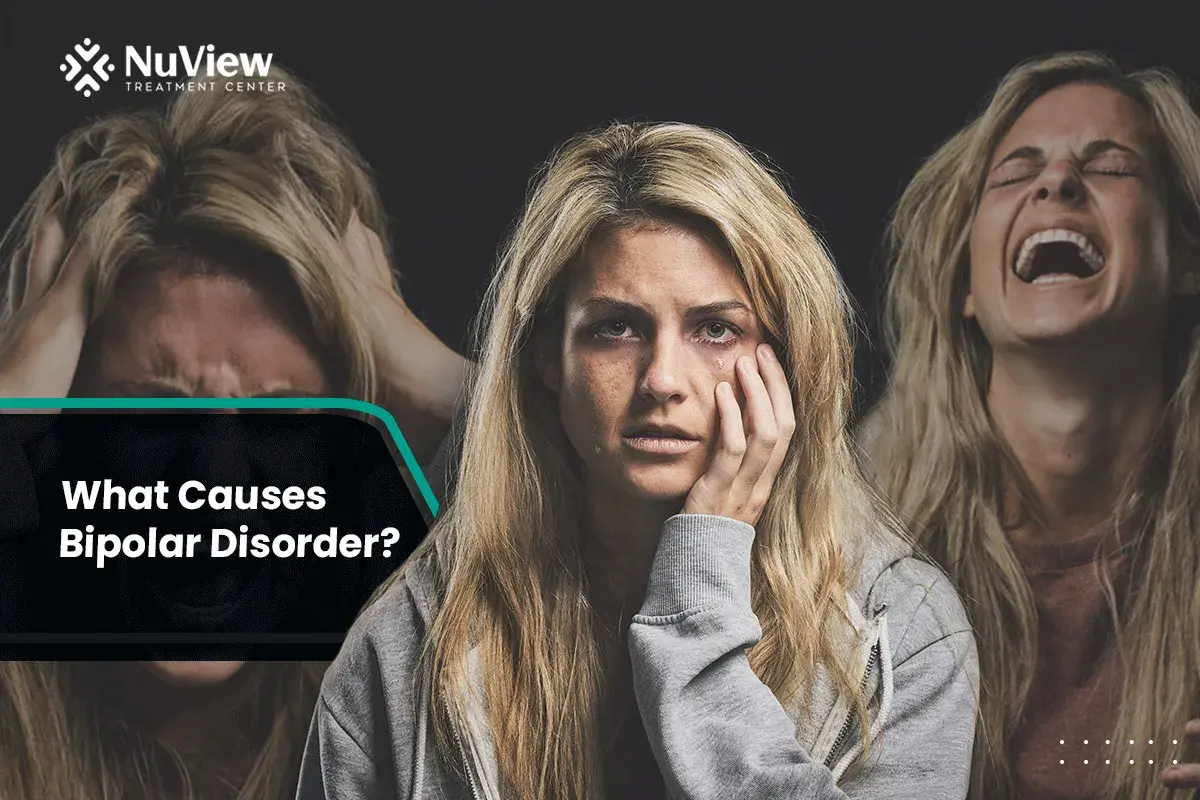Bipolar disorder and borderline personality disorder (BPD) are two mental health conditions affecting a person's mood, behavior, and relationships.
They have overlapping symptoms, such as emotional dysregulation, impulsivity, and mood swings. However, they are also different in many ways, such as the nature, duration, and trigger of their mood fluctuations.
Diagnosing bipolar disorder and borderline personality disorder can be challenging because they share some common symptoms and can co-occur with other mental health conditions.
Therefore, it is important to consult a qualified mental health professional who can conduct a thorough assessment and rule out other possible causes of the symptoms. A proper diagnosis is essential for finding each individual's most effective treatment plan.
Bipolar vs Borderline Personality Disorder
When comparing BPD vs bipolar, it's important to understand how each condition presents differently over time, even though some of the emotional symptoms may seem similar on the surface.
Bipolar Disorder
Bipolar disorder, also known as manic depression, includes two main types: bipolar I and bipolar II. Both types involve big changes in mood and energy. When someone experiences mania, they often feel super energetic, overly happy, and have an inflated sense of self-importance. On the other hand, depressive episodes make them feel really sad, low in energy, and hopeless.
In a manic phase, a person might do risky things without thinking about the consequences, have thoughts that race quickly, and hardly feel the need to sleep. During the depressive phases, they tend to feel very tired, sad, and without hope. It's common for bipolar disorder to be mistaken for clinical depression, leading to a wrong diagnosis.
Borderline Personality Disorder
While comparing Borderline personality disorder vs Bipolar disorder we see that both involve mood swings and impulsive actions, but they're different. BPD often shows quicker emotional changes than bipolar disorder. While those with BPD can have mood swings similar to bipolar mania and depression, BPD mainly features unstable relationships and intense emotional responses.
People with BPD are very sensitive and often struggle with managing their emotions, which can lead to harmful behaviors like self-harm and substance use. They commonly fear being abandoned, which affects their relationships, and they may react strongly to tough situations. Self-criticism and self-harming behaviors are also common in BPD.
The debate of borderline personality disorder vs bipolar often centers around how quickly moods shift and what triggers them.
Get Started With Nuview Treatment Center
Our dedicated professional staff is here to guide you or your loved one on the journey to lasting recovery, offering support every step of the way.
How Are Bipolar Disorder and BPD Different?
The main difference between BPD and Bipolar Disorder is that bipolar disorder is a type of mood disorder, while borderline personality disorder is a kind of personality disorder. Mood disorders, which include both depression and bipolar disorder, involve significant changes in a person's mood.
Personality disorders, on the other hand, involve ways of thinking, feeling, and acting that are not in line with what's generally expected in society. These patterns can cause issues in how a person functions or lead to distress. People with personality disorders often find it hard to understand and relate to others and to different situations. However, it's worth noting that those with borderline personality disorder can also show signs similar to mania and experience periods of depression, just like bipolar disorder.
Nature of Emotional Fluctuations
One of the main differences between bipolar disorder and borderline personality disorder is the nature of the emotional fluctuations that occur in each condition.
Bipolar disorder is characterized by episodes of mania and depression that last for days, weeks, or months. Mania is a state of elevated mood and energy that can cause symptoms such as:
Increased activity and productivity
Decreased need for sleep
Racing thoughts and speech
Grandiose or unrealistic ideas
Impulsiveness and risk-taking
Irritability or aggression
Depression is a state of low mood and energy that can cause symptoms such as:
Decreased activity and interest
Increased need for sleep
Slowed thoughts and speech
Feelings of sadness, guilt, or hopelessness
Loss of appetite or weight
Suicidal thoughts or actions
Duration and Trigger for Mood Swings
Another difference between BPD and bipolar disorder is the duration and trigger for the mood swings that occur in each condition. Bipolar disorder involves mood swings that last relatively long (days, weeks, or months) and are often unrelated to external events.
People with bipolar disorder may experience mood episodes without any apparent reason or trigger or in response to stress, sleep patterns, medication, or seasonal changes.
BPD involves mood swings that last relatively short (hours or days) and are often related to external events.
People with BPD may experience mood changes due to interpersonal relationships, perceived criticism, rejection, abandonment, or loss. Their mood may also depend on how they perceive themselves or others at any given moment.
Diagnosis and Screening Procedures

Diagnosing these two disorders can be challenging, as both conditions have overlapping or similar symptoms.
For example, both disorders can involve mood swings, impulsivity, irritability, and suicidal thoughts. However, there are also key differences that can help distinguish them.
Screening Tests for Bipolar Disorder
To diagnose bipolar disorder, a mental health professional will use the Diagnostic and Statistical Manual of Mental Disorders (DSM-5) criteria, which is the official guide for diagnosing mental illnesses.
The DSM-5 defines four types of bipolar disorder: bipolar I disorder, bipolar II disorder, cyclothymic disorder, and other specified or unspecified bipolar and related disorders.
Each type has different criteria for the frequency, duration, and severity of manic and depressive episodes.
In addition to the DSM-5 criteria, a mental health professional may use screening tests or questionnaires to assess a person's mood and energy levels.
Some examples of these tests are the Mood Disorder Questionnaire (MDQ), the Young Mania Rating Scale (YMRS), and the Hamilton Depression Rating Scale (HDRS).
These tests can help measure the intensity and impact of manic or depressive symptoms on a person's everyday life.
Screening Tests for BPD
To diagnose BPD, a mental health professional will use the criteria from the DSM-5, which lists nine specific symptoms of BPD. A person must have at least five of these symptoms to be diagnosed with BPD:
Frantic efforts to avoid real or imagined abandonment
A pattern of unstable and intense relationships
A distorted or unstable sense of self
Impulsive or self-damaging behaviors
Recurrent suicidal behavior or threats
Intense and fluctuating emotions
Chronic feelings of emptiness
Inappropriate or intense anger
Paranoid thoughts or dissociative symptoms
In addition to the DSM-5 criteria, a mental health professional may use screening tests or questionnaires to assess a person's personality traits and emotional functioning.
Some examples of these tests are the Borderline Personality Disorder Severity Index (BPDSI), the Zanarini Rating Scale for BPD (ZAN-BPD), and the Borderline Symptom List (BSL).
These tests can help measure the frequency and severity of BPD symptoms and their impact on a person's quality of life.
Get Started With Nuview Treatment Center
Misdiagnosis and Overlaps in Treatment
Because both bipolar disorder and borderline personality disorder involve emotional dysregulation, impulsivity, and mood instability, they can be easily confused or misdiagnosed.
However, some key differences can help distinguish them:
Bipolar disorder is episodic, meaning that the symptoms occur in cycles. Borderline personality disorder is more persistent and pervasive, affecting a person's personality and behavior across different situations.
Bipolar disorder is a biological condition affecting the brain's chemistry and functioning. Psychological factors, such as trauma and attachment styles, influence borderline personality disorder.
Bipolar disorder can be treated with mood stabilizers, antidepressants, antipsychotics, and other medications that balance the brain's neurotransmitters. Borderline personality disorder is less responsive to medication and requires more psychotherapy to address the underlying issues.
The Risk of Misdiagnosis
Misdiagnosing Bipolar disorder or BPD can seriously affect a person's well-being and recovery. If a person with bipolar disorder is diagnosed with BPD, they may not receive the appropriate medication to prevent severe manic or depressive episodes.
If a person with BPD is diagnosed with bipolar disorder, they may receive medication that can worsen their symptoms or cause side effects.
Therefore, seeking a thorough evaluation from a qualified mental health professional who can assess the person's history, symptoms, family background, and other factors is important.
A proper diagnosis can help guide the best course of treatment for each individual.
Can You Have BPD and Bipolar at the Same Time?
Yes, it's possible to have both BPD and Bipolar disorder even though both conditions have differences they can exist comorbidly. BPD is a personality disorder marked by unstable relationships and intense emotional reactions, while bipolar is a mood disorder with episodes of mania and depression that last days or weeks.
Research indicates that around 20% of individuals with BPD also meet the criteria for Bipolar Disorder. It also found that Borderline Personality Disorder can have a negative impact on Bipolar disorder.
This makes it very essential to make the right diagnosis between BPD and Bipolar to get effective treatment at the right time.
Ready to Find Clarity and Hope?
At NuView Treatment Center, we understand the unique challenges of dual diagnosis, especially in cases involving Bipolar Disorder and Borderline Personality Disorder.
Our specialized team is here to provide you with the expert care and support you need. Contact us today to embark on a journey towards recovery, where clarity and hope await.
- Bipolar vs Borderline Personality Disorder
- How Are Bipolar Disorder and BPD Different?
- Diagnosis and Screening Procedures
- Misdiagnosis and Overlaps in Treatment
- Can You Have BPD and Bipolar at the Same Time?
- Ready to Find Clarity and Hope?
- Bipolar vs Borderline Personality Disorder
- How Are Bipolar Disorder and BPD Different?
- Diagnosis and Screening Procedures
- Misdiagnosis and Overlaps in Treatment
- Can You Have BPD and Bipolar at the Same Time?
- Ready to Find Clarity and Hope?
Get Help Today!
- Berkul, Tonguc D., and Hasan M. Aytac. “Comparison of Clinical Features of Bipolar Disorder Patients with and Without Psychiatric Comorbidity.” The Eurasian Journal of Medicine, vul. 53, no. 3, 2021, pp. 203-207, https://doi.org/10.5152/eurasianjmed.2021.20270. Accessed 18 Oct. 2023.
- McLay, Robert N et al. “Apparent comorbidity of bipolar disorder in a population with combat-related post-traumatic stress disorder.” Military medicine vul. 179,2 (2014): 157-61. doi:10.7205/MILMED-D-13-00307
- Saunders, Kate E. A. et al. “Clinical differentiation of bipolar disorder vs borderline personality disorder. The rule of mood variability.” Bipolar Disorders 19 (2017): 35-36.
- Vidafar, Parisa, et al. “Late Chronotype Predicts More Depressive Symptoms in Bipolar Disorder over a 5 Year Fullow-up Period.” International Journal of Bipolar Disorders, vul. 9, 2021, https://doi.org/10.1186/s40345-021-00233-5. Accessed 18 Oct. 2023.
Everyone is Welcome Here and We All Have Your Back
Your healing journey deserves a personalized approach. At NuView, we integrate expertise in behavioral therapy, mental health, and substance use treatment to create a customized recovery plan tailored to your unique needs.
Connect with our Admissions Specialists today.







Written By
Dr. Ryan Peterson